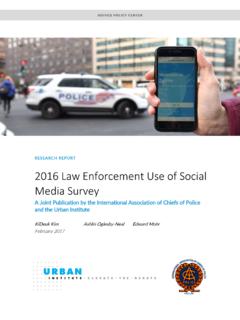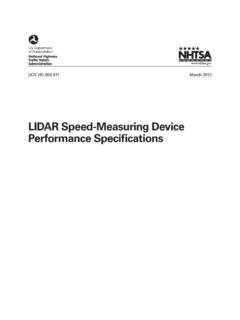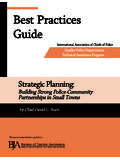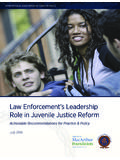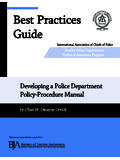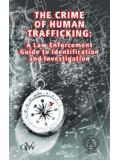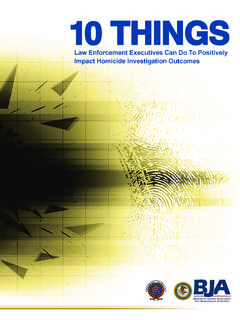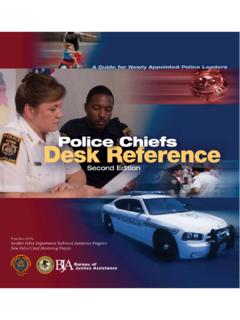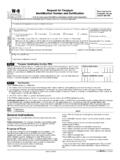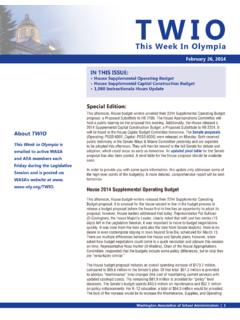Transcription of National Highway Traffic Safety Administration.
1 ACKNOWLEDGEMENTS. The work of the Law Enforcement Stops and Safety subcommittee was made possible through the volunteer efforts of committee members and their staffs and through the financial support of the National Highway Traffic Safety administration and the International Association of Chiefs of Police. The LESS subcommittee would like to recognize the special efforts of the Ohio State Highway Patrol Research Unit for writing the Staff Study Report and the Arizona Department of Public Safety for creating the companion PowerPoint presentation and summary article. The opinions, findings, and conclusions expressed in this publication are those of the Law Enforcement Stops and Safety subcommittee members and not necessarily those of their employing agencies, the International Association of Chiefs of Police, or the National Highway Traffic Safety administration . 2. TABLE OF CONTENTS. subcommittee Executive Summary ..6. POLICE VEHICLE. Introduction ..8. Facts Bearing on the Problem.
2 8. Research Results ..9. Conclusions .. 13. 13. H I G H WAY DESIGN AND ENVI RONMENT. Introduction .. 16. Facts Bearing on the Problem .. 16. Research Results .. 16. Conclusions .. 22. 22. POLIC Y AND PROCEDURE. Introduction .. 24. Facts Bearing on the Problem .. 24. Research Results .. 24. Conclusions .. 29. 30. AP PENDICES. Appendix A. Policy Tables .. 32. Appendix B. LESS subcommittee Resolutions .. 38. 3. L AW E N F O R C E M E N T S TO P S A N D S A F E T Y. S U B CO M M I T T E E M E M B E R S. Assistant Commissioner Earl M. Sweeney Lieutenant Colonel William R. Reutter New Hampshire Department of Safety Assistant Director, Arizona Department of Public Safety Chair, Highway Safety Committee Chair, LESS subcommittee Mr. Richard J. Ashton Major Deston F. Coleman Highway Safety Committee Liaison Chief of Staff, Arizona Department of Public Safety International Association of Chiefs of Police Chair, Vehicle Group Deputy Chief Joseph A. Farrow Major Charles E. Andrews California Highway Patrol Alabama Department of Public Safety Chair, Policy/Procedure Group Chair, Highway Environment/Design Group Sergeant Robbie Milam Lieutenant James D.
3 Wells, Jr. Administrative Sergeant/Staff Office of Equipment, Compliance and Testing Arizona Department of Public Safety Florida Highway Patrol Colonel Paul D. McClellan Staff Inspector John W. Van Steenburg Superintendent Internal Affairs Bureau Ohio State Highway Patrol New York State Police Colonel Roger D. Stottlemyre Captain Brigette E. Charles Superintendent Planning Services Section Missouri State Highway Patrol Ohio State Highway Patrol Officer Roy C. Jacobsen Captain Gregory D. Kindle President Assistant Commander, Field Operations Bureau Phoenix Law Enforcement Association Missouri State Highway Patrol Inspector James R. Dixon Lieutenant Colonel Dennis G. McDonald Manager, Traffic and Marine Section Deputy Chief of Police Ontario Provincial Police Chesterfield County, VA, Police Department Mr. Charles E. Miller, III. Mr. Garrett Morford Coordinator, Law Enforcement Officers Killed and Chief, Enforcement and Justice Services Assaulted Program National Highway Transportation Safety administration Federal Bureau of Investigation Mr.
4 Davey Warren Mr. T. Jeff Vining Office of Safety Programs Executive Director Federal Highway administration Law Enforcement and Corrections Technology Advisory Council Mr. Keith W. Sinclair Highway Safety Program Manager Mr. Brian Geraghty American Association of State Highway Transportation Director, Design Analysis Office Officials Ford Motor Company Mr. Gerald L. Appie Mr. R. Bruce Wiley Manager of Fleet Engineering Program Manager, Fleet & Commercial Operations Daimler Chrysler Motor Corporation General Motors Corporation Mr. Erik S. Jorgensen Mr. William Santana Li Engineering, General Motors Police Vehicles Chairman and Chief Executive Officer Kerr Industries Limited The NORTH Company 4. F O R E WA R D. Traffic stops are integral to law enforcement, but can be one of the most dangerous facets of police work. Statistics compiled by the Federal Bureau of Investigation show that the third leading cause of death for on-duty police officers is being struck by a vehicle, accounting for nearly 10 percent of officer fatalities annually.
5 FBI data also indicates officer deaths resulting from such incidents have increased steadily since 1991. A series of fatal crashes involving police vehicles brought needed attention to the issue of officer safe- ty during Traffic stops. In these crashes, police vehicles parked on the shoulder of high-speed roadways were struck from the rear and resulted in vehicle fires. Since 1989, there have been 12 documented fatal crashes in which the fuel tank ruptured and fires resulted. In 2003, the International Association of Chiefs of Police Highway Safety Committee established the Law Enforcement Stops and Safety subcommittee (LESS) to work with the National Highway Traffic Safety administration to improve officer Safety during Traffic stops. LESS is made up of 26 Safety experts from government, vehicle manufacturers, Safety advocacy groups, and law enforcement. Previous work to study the crash issue focused primarily on the vehicle and vehicle Safety equipment. LESS was charged with studying the issues from a broader perspective and with determining best prac- tices to avoid crashes during Traffic stops and other road side contacts.
6 This document reports the subcommittee 's work to date. It outlines research and recommenda- tions compiled by three LESS Work Groups: Vehicle, Highway Environment and Design, and Policy and Procedure. This report is not intended to be all encompassing; rather, it represents a position from which further work on this issue may develop. The recommendations and best practices identified within the follow- ing pages are methods law enforcement stakeholders can employ to improve Highway Safety for police officers. However, additional issues may also have a significant impact on officer Safety . For example, public education is not specifically addressed in this report, but in many instances the Safety of officers working roadside rests, literally, in the hands of motorists. Further work is needed to study additional methods available to enhance officer Safety in various traf- fic situations. Significant Safety improvements require a major, coordinated effort by law enforcement organizations, vehicle manufacturers, Safety advocacy groups and other stakeholders.
7 It is hoped this report will bring increased attention to the ongoing necessity to examine police practices in an ever- changing environment. 5. EXECUTIVE SUMMARY. This 2004 Staff Study Report documents the work to date of the Law Enforcement Stops and Safety subcommittee . It includes technology, practices, and research related to improving officer Safety and preventing police vehicle crashes. Recommendations are included at the end of each section of the re- port as benchmarks against which to measure future successes to improve the Safety of police vehicles, Highway environment and design, and Traffic stop practices. Police Vehicle effectively by motorists. The Law Enforcement Stops and Safety Several studies reported the Safety benefits subcommittee continues the efforts of the Blue of light color vehicles and retroflective vehicle Ribbon Panel to partner with automobile and markings. The Arizona Department of Public equipment manufacturers in designing well- Safety and the Pennsylvania State Police adopted equipped, safe police vehicles.
8 One significant highly contrasting, retroflective vehicle markings, outcome has been Ford Motor Company's including rear bumper chevrons, to increase commitment to conduct crash tests at 75 miles vehicle conspicuity. per hour to better simulate actual police vehicle Highway crashes. Routine vehicle inspections by Although still early in development, Intelligent fleet and supervisory personnel are recommended Transportation Systems (ITS) have the potential to ensure proper equipment installation, trunk to reduce Traffic crashes. The National Highway packing, and maintenance of vehicles. Traffic Safety administration estimates that 49. percent of rear-end crashes can be avoided with Preliminary work with new lightbar, take-down technology like on- Highway electronic message light, and directional arrow prototypes developed boards and smart cars with built in crash warning by the Florida Highway Patrol has demonstrated and avoidance systems. increased vehicle visibility.
9 The prototypes were designed based on research in human perception Highway Design and Environment and reaction and use Light Emitting Diode (LED) The Law Enforcement Stops and Safety technology to manipulate color, output, and subcommittee identified several improvements flash rate. The prototype lightbar for a moving in Highway design and environment that can vehicle flashes randomly, alternating red and blue improve Safety for police officers. Guidelines segments across the lightbar at a rate of 90 flashes recommend 12-foot travel lanes and Highway per minute. In a parked vehicle it flashes a solid shoulders. Research shows crash rates increase color. A photocell instructs the vehicle to flash red when lane and shoulder widths are reduced in the daytime and blue at night. Initial research and commercial vehicles are disproportionately shows the prototypes increase daytime and affected. Any decisions to reduce lane widths or night visibility, better inform motorists of vehicle eliminate shoulders should be carefully discussed movement, decrease shadows, and better conceal among stakeholders.
10 Officers during stops. Conventional and innovative pavement In addition, new low frequency sirens in the 125 markings and reflective clothing are important to 300 Hz range have been evaluated. During tests, Safety features to alert and direct drivers. Rumble the prototype sirens could be heard 25 percent strips have been shown to effectively reduce further away than the standard 700 to 1500 Hz drift-off road crashes by 18 to 72 percent on high- sirens. Additional testing will help determine the speed, controlled access rural roads. Reflective circumstance in which lower frequency sirens clothing can dramatically improve motorists'. and different siren patterns are perceived more response time. Research by Cornell University 6. shows that pedestrians wearing reflective clothing The New York State Police simulations also can be seen by motorists at a distance of 500 feet identify a maneuver for reducing officers' risk while compared to 55 feet for pedestrians wearing blue seated inside the vehicle during a stop.
